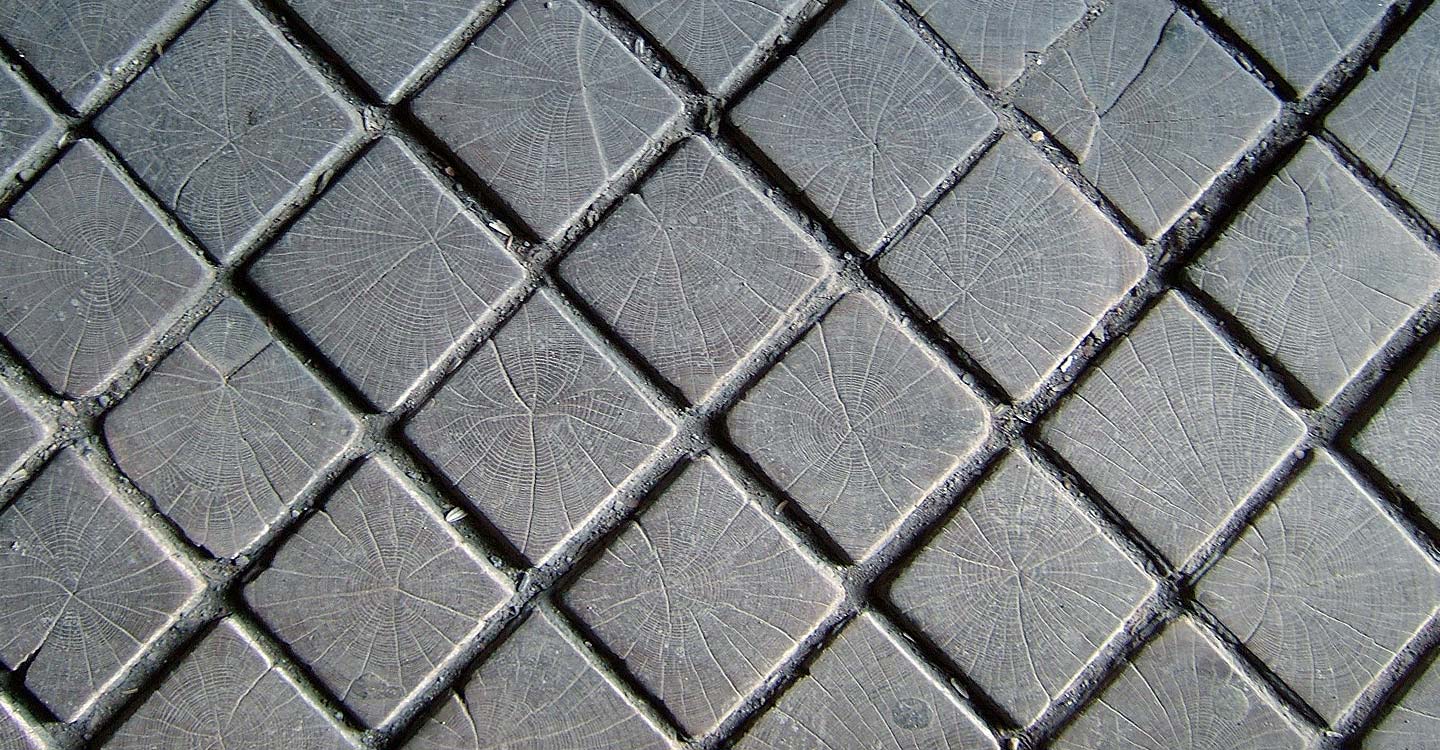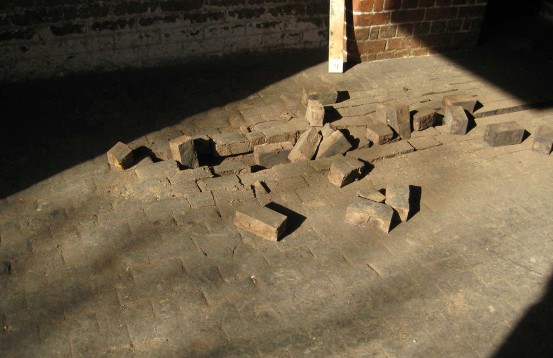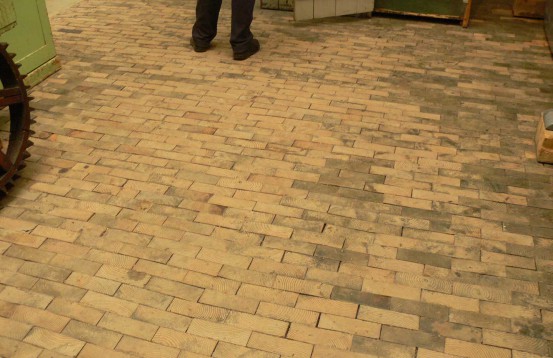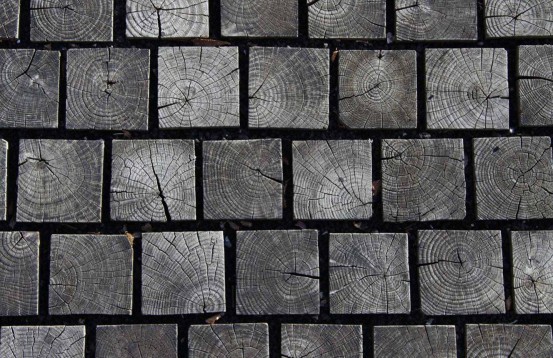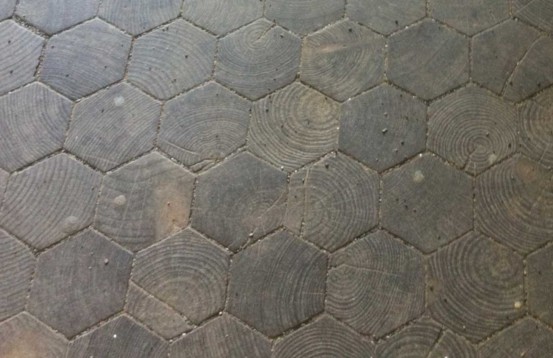Summary
Endgrain timber has been made into tiles and cobbles for centuries. Their main use was as a surface for paving and roads. The first blocks were round or hexagonal and were used in streets and pavements in Europe, America and Russia. They were popular in the 19th and early 20th centuries, as they provided a safer surface for horses and wagons. Wooden cobbles gave a better grip for horse shoes and the iron rims on wheels. In London in the late 1800’s the City Surveyor, Mr Hayward, made daily observations of accidents “over a long period”. He concluded that “A horse would travel before falling. 132 miles on granite set paving, 192 miles on asphalt and 446 miles on wood.”
Different woods were used for cobbles and creosoted blocks of Norway pine was popular in many large cities. Wooden cobbles also reduced the noise of traffic. This was of great benefit, especially around the entrances of Victorian train stations in London, where noise echoed off their high vaulted ceilings.
At the beginning of the 1920s endgrain block flooring was also used in major European and American engineering factories. It provided a more forgiving surface for dropped metal components. This industrial flooring is still in use today.
Recently endgrain tile flooring has become more widely used in public buildings and private homes. It is labour intensive to manufacture making it an expensive, but quality product. However it is highly durable compared to long grain timber and makes very attractive and striking flooring. Cobbles are back in vogue as architects and designers appreciate the many qualities that the endgrain of timber offers.
Wooden Roads
There is considerable archaeological evidence from right across Europe for the use of wood as a path or road surface, particularly over boggy areas. From the Bronze Age, nearly 4000 years ago, and up into the twentieth century people have constructed woven wattle paths and log corduroy roads. Some are simple constructions of cut timber laid side by side on the ground, while others are more elaborate constructions demonstrating early carpentry skills.
Wooden roads are not restricted to ancient history. They played a role in road and street construction into the first half of the 20th century before larger and larger motorised vehicles forced them into obscurity. In America, with substantial areas of natural forest, wood was a common building material. America not only used it for building homes, barns, fences, furniture but for roads and streets.
In 1851, Hunt’s Merchant Magazine and Commercial Review reported that plank roads had originated in Russia. Lord Sydenham introduced them in Canada and New Yorkers of Onondaga County, impressed by the Canadian experiment, brought them to the United States. The roads were promoted enthusiastically in communities left behind by railroad and canal construction. Where trees were plentiful, a plank road could be built for about $1,900 a mile, whereas macadam would have cost $3,500 per mile.
Wooden Cobbles
While people in rural areas were building plank roads, their urban counterparts were laying wood-block avenues and streets. J. Lee Stevens, a promoter of wood for city streets, published a pamphlet in 1841 which publicised the wood block which paved the streets of London. Steel-tyred wagons and carriages pulled by iron-shod horses amplified a deafening clatter against granite, cobblestones and brick laid to guarantee all-weather surfaces for urban streets.
However metal shoes and wheels wore away paving in less than a decade, so repaving became an essential municipal function. Stevens advocated replacing harder surfaces with wood blocks because of their sound absorption quality. He insisted that wood outlasted stone and was less expensive to install and replace. Stevens estimated 20-year savings of between10% and 30% where wood blocks were substituted for granite.
In 2006 David Whitten, of Auburn University, produced a detailed report entitled “A Century of Parquet Pavements: Wood as a paving material in the United State and Abroad, 1840-1940’. He investigated the global distribution of wood paving blocks, the changes in technology of wood-block treatment, placement and improvement, and the reasons for the disappearance of wood as a paving material. His research has given us a clear understanding of the history and importance of wooden cobbles.
The first examples of endgrain cobbles in London were round or hexagonal and some still remain today. The first cobbles were made from imported Swedish softwoods, which were later replaced by Australian hardwoods, including Jarrah and Kari Eucalyptus. Other British cities opted for Jarrah cobbles following the success of a year-long lecture tour of Europe between 1896 and 1897 by Richard Watkins Richards, Sydney’s city surveyor. He extolled the virtues of Australian hardwoods for street paving. In a paper written in 1904 he claimed the hardwoods, including Blackbutt, Tallowwood, Bluegum, Red Gum, Turpentine and Mahogany, were the “nearest to the perfection of an ideal carriageway pavement for all conditions, as traffic, climatic, meteorological and constructional, that are met within cities of all countries”.
Endgrain cobbles were said to provide a better surface for horses and wagons with their iron rims. The City of London’s surveyor at the time, a Mr Hayward, made daily observations “over a long period” and concluded that “A horse would travel before falling 132 miles on granite set paving, 192 miles on asphalt and 446 miles on wood.’’
London boasted wood-block streets as early as 1840. By 1915, wood-block paving was in general use in cities and large towns across Britain. Its growing popularity was due to the fact that it had a longer life under motor-bus traffic than any other smooth pavement that had yet been introduced at an equal expense. Other benefits were the ease with which repairs could be made and the absence of dust and noise.
In 10 of the 28 London boroughs there was 121 miles of creosoted wood block in 1912, including 40 miles in the city of Westminster, where the best retail business streets, government buildings, theatres, museums and art galleries were located. Other cities and large towns across the country adopted wood paving for some of their best streets. In 1915, Canadians anticipated the end of World War I and likely demand for Douglas fir, white spruce, jack pine and red pine for paving British streets. The quantity of timber used by Great Britain for paving in 1913 was estimated to be 60 million feet.
London’s most famous streets were still covered in wood blocks until the 1920s and a few into the 1930s. ‘Bartholomew’s Road Surface Map of London’ from 1922, shows most of London’s roads surfaced with wooden blocks. A copy is held by the National Library of Scotland. However, by 1925, wood paving was finished as a road material and was replaced with tarmacadam.
Across the Atlantic in America, New York built more than 3,500 miles of wooden roads from 1847 to 1853. It is recorded that James G. McBean, a wood block paving contractor, offered to pave half of Washington Street, between LaSalle and Clark streets, in Chicago, with cedar blocks in 1892.
One of the earliest examples wood block flooring in Wales can be found at Cwrt Plas Yn Dre, in Newtown, Powys. It is also known incorrectly as Owain Glyndwr’s Dolgellau Parliament House. This Grade II listed hall house dates to the late 15th century. It was moved from Dolgellau in 1885 and heavily restored when it was rebuilt. Interestingly it has three inch end grain random oak wood block flooring. The date of its reconstruction is set in the floor using the pattern of the blocks.
In Paris a trial was undertaken of a new system of wood-paving in 1892. Wood paving was also used in the busiest sections of the streets of Melbourne and Sydney in 1894 and Tokyo used creosoted Douglas fir blocks for paving in 1923. A variety of species of timber were used, with creosoted blocks of Norway pine proving satisfactory in many large cities.
The Advantages and Disadvantages of Wood Block Paving
Surveyors and engineers of the period debated the advantages and disadvantages of wood as a material for road services. In general it was felt that the advantages were that wood blocks or cobbles:-
- Minimised noise;
- Were safer for horses than granite or asphalt;
- Gave better traction than asphalt;
- Were much cleaner than Macadam;
- Presented an even, slightly elastic surface which was a great boon to vehicular traffic
- Were safer than any other pavement on inclines.
On the downside they felt that:-
- Wood absorbs moisture and gave off offensive smells;
- Was difficult to keep clean in certain weather conditions;
- Was not easy to repair after opening for gas and water pipes
Wooden blocks also made economic sense. The life of wood paving was from nine to twelve years, after which re-paving would be necessary. However half of the blocks would be fit for reuse. Practical experiments showed that, provided the wood used was suitable for paving, the loss of 1/16th of an inch from a 4.5 inch thick block in a busy street over a period of two-and-a-half years was acceptable.
Wood paving blocks provided a solution as industrial societies around the globe grappled with the high noise levels in their growing cities. During the decades before pneumatic rubber tyres eased the ride and reduced the clatter of steel-wheeled vehicles and iron-shod horses wood blocks were the answer. However the situation was about to change and as Whitton states; “The use of wood-block paving should be considered in light of the demands of turn-of-the-century streets and highways and not in terms of modern construction materials. Wood-block paving was not a failure, it disappeared because needs changed,”
Wood-blocks were not intended as an all-purpose paving material but a special substance for selected streets. City engineers did not envisage a city paved with wood. They felt that wood blocks were appropriate for streets near hospitals, schools, churches and public buildings, like court houses. In these circumstances and in congested streets with heavy traffic where street noise was a great problem, wood was the solution. “Wood-block paving was not a whimsy but a solution to a serious urban problem.”
Whitton comments; “It is not easy for modern men and women to imagine the noise generated by hundreds of steel-tyred wagon wheels and horse shoes on bricks, steel iron, or granite block streets sandwiched between multi-levelled buildings. A wooden pavement was no small blessing in the horse and wagon society. Wood blocks were also useful in filling gaps around trolley tracks. The flexible wood was less likely to crack, break, or wander from the vibrating iron or steel rails.”
Some Other Uses of Endgrain Timber
At the beginning of the 1920’s endgrain block flooring was also used in major European and American engineering factories. It provided a more forgiving surface for metal components if dropped. This industrial flooring is still being used today.
One of the earliest car manufacturing plants in Detroit, USA, the Fisher Body Works, had wood cobble floors. The plant which made Model T Fords was six stories high and used wooden cobbles to absorb vibration from heavy machinery and to reduce noise levels. There are also reports of the cobbles soaking up any escaping oil. Wood block flooring is still used today in many heavy industries in the USA, including bearing and aluminium production, canon manufacturing, power plants and warehousing, in essence any place where a tough floor is needed.
In recent years, endgrain tile flooring has become more widely used in many public buildings and private homes. As well as being attractive and striking, it is highly durable compared to side grain timber.
Sycamore and beech endgrain timber have also been used for butcher’s blocks due to its tough, durable and hygienic surface, capable of withstanding repeated blows from cleavers without dulling the blade.

